| HPS 0410 |
Einstein for Everyone |
|
Back
to main course page
Special
Theory of Relativity: The Principles
John
D. Norton
Department of History and Philosophy of Science
University of Pittsburgh
Background reading: J. Schwartz and M. McGuinness,
Einstein for Beginners. New York: Pantheon.. pp. 66 - 151.
"On the Electrodynamics of Moving Bodies"
Special relativity was born in June of 1905, when an inconspicuous patent
examiner in Bern, Switzerland, sent a paper to the leading physics journal
of his time, Annalen der Physik. These images might help to give
a picture of Albert Einstein in this
pivotal year. In the paper, Einstein argued that altering our understanding of the
behavior of space and time could resolve certain problems in
electrodynamics.
Here is the first page of that paper:
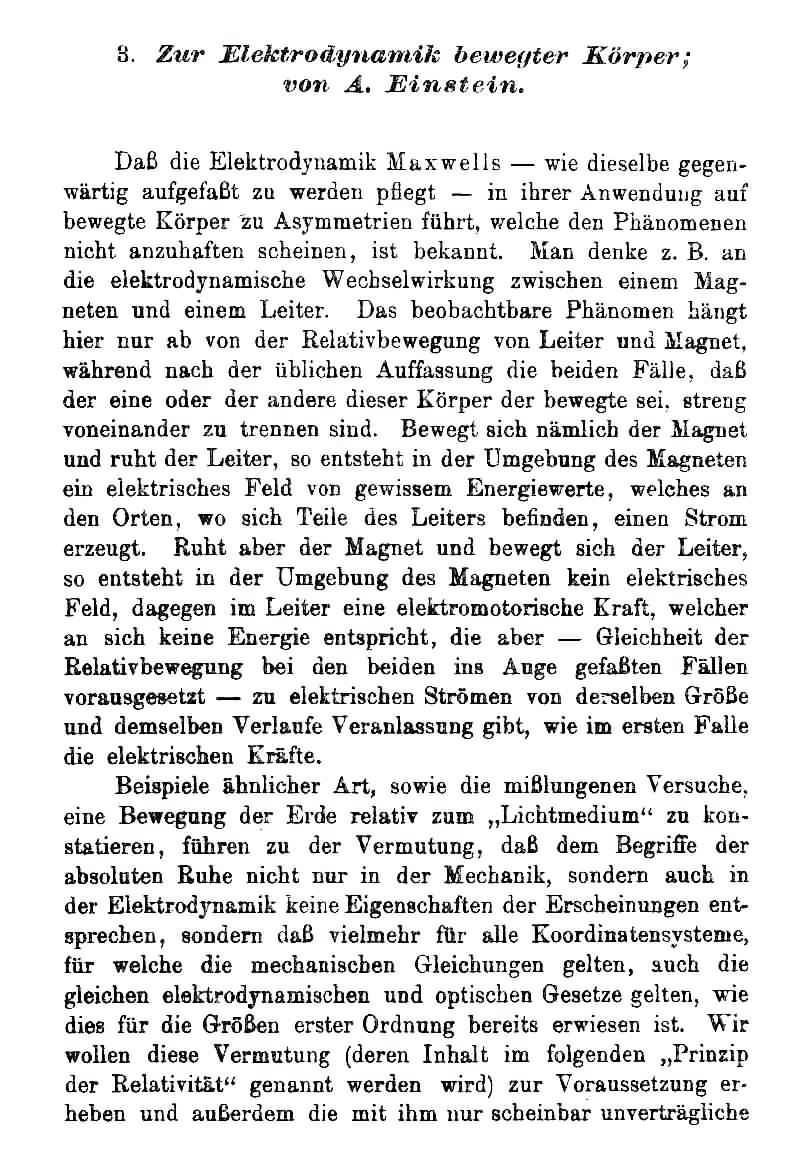
Many of you will not follow the German. Here is a standard English translation:
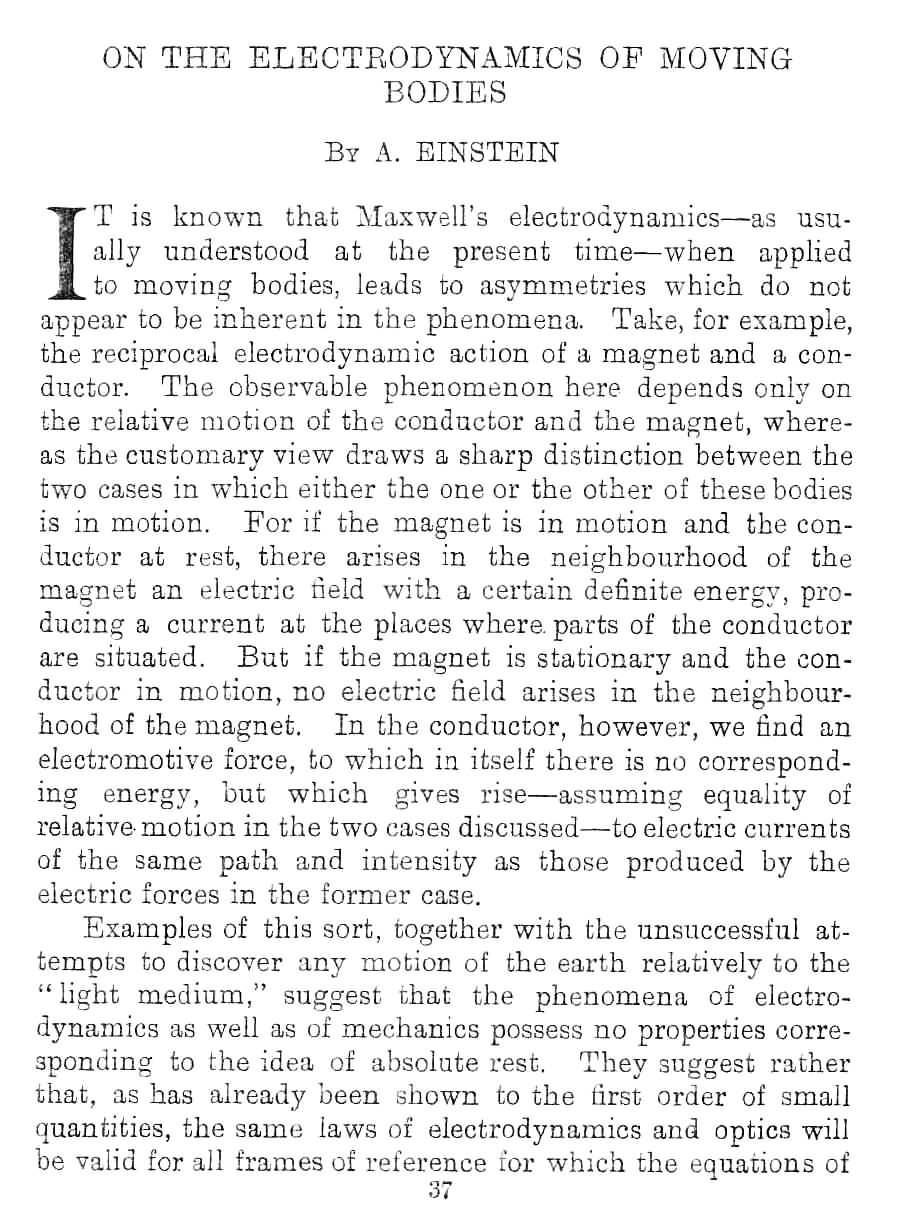
This is surely not what we would expect. Should the paper not have
a more interesting title like "Strange Things about Space and Time"?
And what is all the fuss about electricity and magnetism? We shall see
that the answer to this question will tell us just how Einstein discovered
his theory. That is coming later. For now, let us get the basics.
The theory Einstein described is now known as the "special theory of
relativity." It is a "theory of relativity" because it is based on the
relativity of inertial motion. The qualification "special" was not
originally part of the theory. Over the coming decade, Einstein sought to
develop his theory of 1905 in a way that would extend the treatment of
relative motion to accelerated motion and would, at the same time,
incorporate gravitation. The theory of 1905 came to be called the
"special" theory to distinguish it from the later extension, "the general
theory of relativity."
To understand Einstein's special theory, we need some
preliminary notions.
Inertial and Accelerated Motion
There is a preferred motion in space known as inertial motion. Any
body left to itself in space will default to an inertial motion,
which is just motion at uniform speed in a
straight line. The easiest example to visualize is a huge
spaceship with the engines turned off, gliding through some remote
part of space, far away from stars and planets.
At any point in space, many inertial motions are possible. They will
be pointed in different directions and will be at different speeds.
The existence of such motions as the natural default is a
fundamental fact about space and time. We need to discover
which of all possible motions in space comprise the
inertial motions. We do that by observing things in motion when they
are free of deflecting forces; or by correcting the motions we
observed for the deflecting effects of these motions.
This is an important point. The loose
talk surrounding relativity theory could lead one to think that
empty space is nothing at all. That idea is not sustainable in
special relativity. In the theory, empty space is rich in
structure. Part of that structure is the existence of special
motions, the inertial motions. |

Based
on a file that has been donated to the Wikimedia Foundation and
released into the public domain by Pearson Scott
Foresman.http://commons.wikimedia.org/wiki/File:Spacecraft_(PSF).png |
|
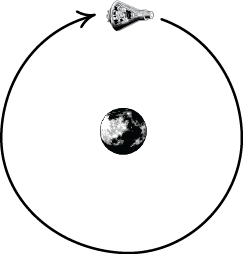 |
Any other motion is accelerated.
This includes motion at uniform speed in a circle. While the speed
stays the same, the direction does not. So the motion is
accelerated. |
|
Sometimes we will talk of an "inertial
observer." It is just an observer who moves inertially. |
 |
|
 |
Such an observer might set up an elaborate system of measuring
rods and other physical devices to fix the positions of events;
and an elaborate system of clocks to fix their timing. Such a
system is an inertial frame of reference.
The figure shows one way that we might build an inertial frame. We
fill space with an array of clocks and use them to determine the
time of an event coincident with the clock. We connect the clocks
with measuring rods so that we can locate any point in the frame
merely by giving directions in the form of three numbers.
"(4,3,7)" means, say, go right 4 rods from the starting point, up
3 and then back 7. We identify different events at the spatial
location in the frame by the different times read by the clock at
that location.
What is important is that the frame consists
of physical devices--typically measuring rods and
clocks--that are at rest relative to the inertial observer. This
is important since we shall see shortly that the lengths and times
read by such devices are affected by their motion, according to
special relativity.
|
We measure times elapsed with these clocks and
distances with these rods.
That is, when lengths, times and other quantities are referred to an
inertial frame, we speak of the magnitudes that would result from
measurements using the rods and clocks of the inertial frame. If an
asteroid fragment is "100 feet long in
the inertial frame," that means that it would be measured to have a
length of 100 feet by the measuring rods of the frame.
If an astronaut taps a finger on the controls of a spaceship "once
per second in the inertial frame," those seconds are measured by the
clocks of the inertial frame. |
 |
 |
It is the same when we speak of motion with
respect to an inertial frame of reference. If some spaceship
moves uniformly in a straight line in the frame, that means
that it covers equal distances in the frame in equal time, while
moving in one direction. The "equal distances" are distances as
measured by the rods of the frame. The equal times are times as
measured by the frame's clocks.
Such a motion is shown in the figure. The spaceship passes from
clock to clock in equal times, as indicated by the clocks recording
"1," "2,", "3," etc. when it passes them. The distances between the
clocks are the same: one rod length. Therefore the spaceships moves
equal distances in equal times (and in the same direction.) |
Strictly speaking, an inertial frame must be
realized by introducing real rods and clocks into space. The above
scheme would require that space be filled by them. That is not the
sort of thing that can be done easily. In practice, it is rarely
done. For we can predict in most cases what measurements would
result were we to fill space with rods and clocks of an inertial
frame of reference.
When we say the spaceship is "moving uniformly in a straight line in
the inertial frame," we really mean that if
we were to fill the space with the appropriate
rods and clocks, we would measure it to be moving so. |
 |
Absolute versus Relative Motion
Relative motion arises when one body
moves with respect to another.
For example, our spaceship might move relatively to a nearby planet. |
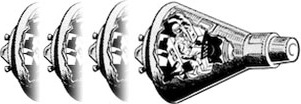

|

 |
Correspondingly the planet moves relative to the spaceship.
These are two ways of describing the same relative motion. |
See an animation.
Prior to Einstein, it was generally thought that there was another sense
of motion, absolute motion. According to this
sense, there is a fact of the matter as to whether the spaceship is
moving, without regard to whether it moves relative to another object,
such as a planet. There is an absolute state of rest in space, according
to this earlier view. Either the spaceship is in this state and at rest;
or it is not and it is moving. Einstein's theory did away with this notion
of absolute rest and absolute motion.
Under this earlier, discarded view, this spaceship just
moves, period. That it moves does not require any
further reference to other objects. It is an unconditional, that is,
absolute, fact.

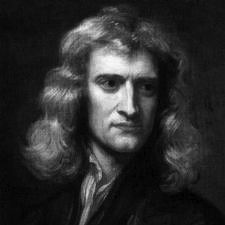 |
The terms "absolute
motion," "absolute place and "absolute space" were
introduced by Isaac Newton as part of the foundational work of his Principia.
There he laid out the a system of mechanics that we now know as
Newtonian. In his introductory discussion, he wrote:
"Absolute
motion is the translation of a body from one absolute place into
another; and relative motion, the translation from one relative
place into another."
Einstein's theory of relativity is usually understood as a
repudiation of these notions of Newton's. |
We shall see that Einstein's theory does discard
the absolutes of Newton's physics by introducing the idea of the
relativity of all inertial motion. That means that we cannot distinguish
any special motions among all the inertial motions, such as a preferred
rest state. We cannot say that this one is fast, that one is slow and
another is at rest. We must always add a qualification. We must say that
this is one is fast with respect to that; that one is slow with respect to
another; or at rest with respect to another again.
In his special theory of relativity, the relativity of
motion is implemented only for inertial motions.
It does not extend to accelerated motions. They are motions that change
their speed or direction or both. We can still say that something
accelerates without adding a further qualification "with respect to...".
Thus, acceleration is an absolute for Einstein's special theory.
Acceleration is discoverable by an
experiment within a closed body. If the body is accelerating,
that will be revealed by effects within the body. For example, an airplane
flies inertially until it hits an air pocket. Then the plane
lurches--accelerates--and things inside are thrown about. Everyone inside
has no doubt of the acceleration.
Beware of oversimplified slogans. slogan like "It's all
relative." or "All motion is relative." That is not what we learn from
Einstein's special theory. It eradicates absolute motion. We learn that
something can only be at rest if it is at rest with respect to something
else. So the better slogan would be "All rest is
relative."
Einstein found it most convenient to base his theory of
relativity on two postulates; once
they were assumed it became an exercise in logic to develop the whole
theory. The two postulates are
I. The Principle of
Relativity and
II. The Light Postulate.
I. The Principle of Relativity
The first principle, the principle of relativity, says
something about all the laws of physics. To state the principle, we must
first express those laws in a particular way, that is, in terms of the
quantities defined within an inertial frame
of reference.
Take Newton's first law of
motion, for example. (It is a law that also holds in special relativity.)
It says in Newton's original wording:
Every body continues in its state of rest, or in
uniform motion in a right [straight] line, unless it is compelled to
change that state by forces impressed upon it.
The terms used in this formulation of Newton's first law
require that we refer to some inertial frame of reference. "State of rest"
means that the body remains at the same position in the inertial frame
over time. "Uniform motion" means that the body covers the same distance
in the same time, where distance is measured by the frame's measuring rods
and time is measured by the frame's clock.
The principle of relativity asserts:
The laws of physics are the same in all inertial
frames of reference.
That just means this. If we express some law of physics
using the quantities of one inertial frame of reference, the resulting
statement of the law will be exactly the same in any
other inertial frame of reference.
We can use the example of Newton's first law of motion to
illustrate the principle. Assume that we have three different inertial
frames of reference, corresponding to the three observers shown below,
then the statement of the law is the same in each frame. That means that
we write down exactly the same sentence to
express the law in each inertial frame. The terms like "state of rest" and
"uniform motion" are to be expressed in the quantities of each frame.
That the law has exactly the same form in each inertial
frame of reference precludes absolute motions.
To see why absolute motions are precluded, consider a
pre-Newtonian view of motion. According to it, all motions would
automatically slow down until they arrived at a unique state of rest. This
law cannot be formulated in the same way in all inertial frames of
reference. We would need one form of the law if the frame at issue is the
true rest frame. We would need a different form in all the other frames of
reference.
This is illustrated below. Assume that the middle motion
is the unique state of rest "A". Then the pre-Newtonian law is expressed
differently in the other two frames and in a way that requires specific
mention of the unique state of rest "A".
That is, we infer from the
principle of relativity:
Absolute motion cannot appear in any law of physics.
Note: we infer this from
the principle of relativity. So this conclusion might not say as much as
the principle does. It might be logically weaker. That is, this conclusion
is not the principle itself.
There are more important conclusions that we will draw
from the principle of relativity. One of the most useful pertains to
experiments. To make the connection, we need to see that laws of nature
are really compact summaries of a huge range of
possibilities.
For example, Ohm's law just
tells us that the voltage across a resistor is proportional to the current
flowing. That proportionality is really a summary statement of a huge
number of facts, each of which applies to a specific case.
|
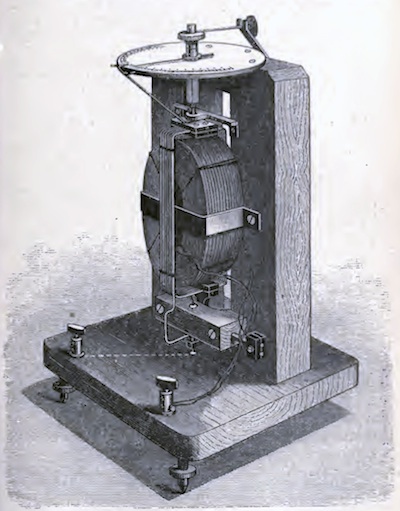
Siemens electro-dynamometer for
measuring strong currents.
p.58 in J. E. H. Gordon, School
Electricity. London: Sampson Low, Marston, Searle, &
Rivington, 1886.
|
It says:
For a 1 Ohm resistor:
When the voltage is 1V, the current is 1A.
When the voltage is 2V, the current is 2A.
When the voltage is 3V, the current is 3A.
When the voltage is 4V, the current is 4A.
...
For a 2 Ohm resistor:
When the voltage is 2V, the current is 1A.
When the voltage is 4V, the current is 2A.
When the voltage is 6V, the current is 3A.
When the voltage is 8V, the current is 4A.
...
And so on indefinitely for many more cases. |
Each one of these possibilities describes
a little experiment and tells us what the result must be. For
example, one of them tells us that, if we procure a 1 Ohm resistor and
apply a voltage of 2V ("Volts") to it, 2A ("Amps") of current will flow.
Imagine now that we carry out this experiment in one
inertial frame of reference. Assume that the experiment succeeds,
returning the above result of 2A of current. We now know that this
possibility is one of the possibilities listed by the applicable law of
physics.
Since the laws are the same in each
inertial frame of reference, it follows that the lists of
possibilities in each inertial frame of reference are the same. Hence if
the experiment proceeds as described in one inertial frame of reference it
must also proceed in the same way in any other inertial frame of
reference.
Combining these last two ideas we conclude:
All experiments run the same in all inertial frames of
reference.
We can represent this consequence using the three inertial
frame of reference described earlier, as follows:
 |

|
 |
| A voltage of 2V was applied to a 1 Ohm resistor. 2A of current
flowed. |
A voltage of 2V was applied to a 1 Ohm resistor. 2A of current
flowed. |
A voltage of 2V was applied to a 1 Ohm resistor. 2A of current
flowed. |
|

|

|

|
If we turn this result around, we can recover
another useful consequence of the principle of relativity.
All experiments run the same in all inertial frames of reference.
That means that anything that happens in one inertial frame can also
happen in any other. It follows that there can
be no sign that the inertial frame you are in is
intrinsically special, that is, in itself different from the others.
Thus no experiment can pick out just one inertial frame of reference
as distinguished. Since absolute rest and absolute motion, if
detectible, would require just such a distinguished rest frame, we
can conclude: |
No experiment can reveal the absolute motion of the
observer.
This is a consequence of the principle of relativity. Another
way to see it is to recall that the principle of relativity leads
us to conclude that absolute motion cannot figure in any law of physics.
But if it is not in the laws and the laws determine what can be, then
absolute motion cannot be. So no experiment could detect it!
Finally, to repeat a remark made earlier, we need to
preclude a misunderstanding can arise easily. It is common to see loose
talk that all motion is relative. This is careless talk. The principle of
relativity of Einstein's special theory is restricted to inertial motion.
The relativity it asserts does not extend to
accelerated motion. If something accelerates, then it does so
absolutely in Einstein's theory. There is no need to say that it
"accelerates with respect to..." A traditional indicator of acceleration
is inertial forces. If you are in an airplane that flies uniformly in a
straight line, you have no sense of motion. If the airplane hits
turbulence and accelerates, you sense immediately the acceleration.
Inertial forces throw things around in the cabin. Those effects reveal the
absolute acceleration of the airplane.
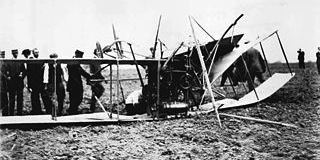
http://upload.wikimedia.org/wikipedia/commons/thumb/f/fa/Men_inspecting_wreckage_of_first_Toronto_airplane_crash.jpg/320px-Men_inspecting_wreckage_of_first_Toronto_airplane_crash.jpg
Here is the principle of relativity and the three
important consequences collected in one place.
Principle
of Relativity: The laws of physics are the same in all inertial frames
of reference.
It follows that:
Absolute motion cannot appear in any law of physics.
All experiments run the same in all inertial frames of reference.
No experiment can reveal the absolute motion of the observer.
Before we move on to the second principle, here's an
animation that shows the key idea of the principle of relativity applied
to experiments. Imagine two spaceships, each moving inertially in space
but with different velocities. If we conduct the
same experiments on each ship, we will end up with the same
result ("27") no matter which spaceship we are on:

II. The Light Postulate
The light postulate is much narrower in scope. It makes no
reference to all the laws of physics, as does the principle of relativity.
Rather it refers to the propagation of light. If we have light propagating
in any inertial frame, we measure its speed using
the rods and clocks of that frame. We will find:
The speed of light is the same in all inertial
frames of reference.
That speed is 186,000 miles per
second or 300,000 kilometers per second. Because this speed crops
up so often in relativity theory, it is represented by the letter "c".
The speed referred to here is the speed of light
in a vacuum. Light passing through any dense medium, such as
glass or water, is appreciably slowed by the medium. Light in water
travels at 75% its speed in a vacuum. There is even a very slight effect
in air. But it is very slight: a slowing of 0.03%

| That Einstein should believe
the principle of relativity should not come as such a
surprise. We are moving rapidly on planet earth through space. But
our motion is nearly invisible to us, as the principle of relativity
requires. |
Why Einstein should believe the light postulate is a
little harder to see. We would expect that a light
signal would slow down relative to us if we chase after it. The
light postulate says no. No matter how fast an inertial observer is
traveling in pursuit of the light signal, that observer will always find
the light signal to be traveling at the same speed, c.
c
The principal reason for Einstein's acceptance of
the light postulate was his lengthy study of electrodynamics, the
theory of electric and magnetic fields. The theory was the most advanced
physics of the time. Some 50 years before, Maxwell had shown that light
was merely a ripple propagating in an electromagnetic field. Maxwell's
theory predicted that the speed of the ripple was a quite definite number:
c .
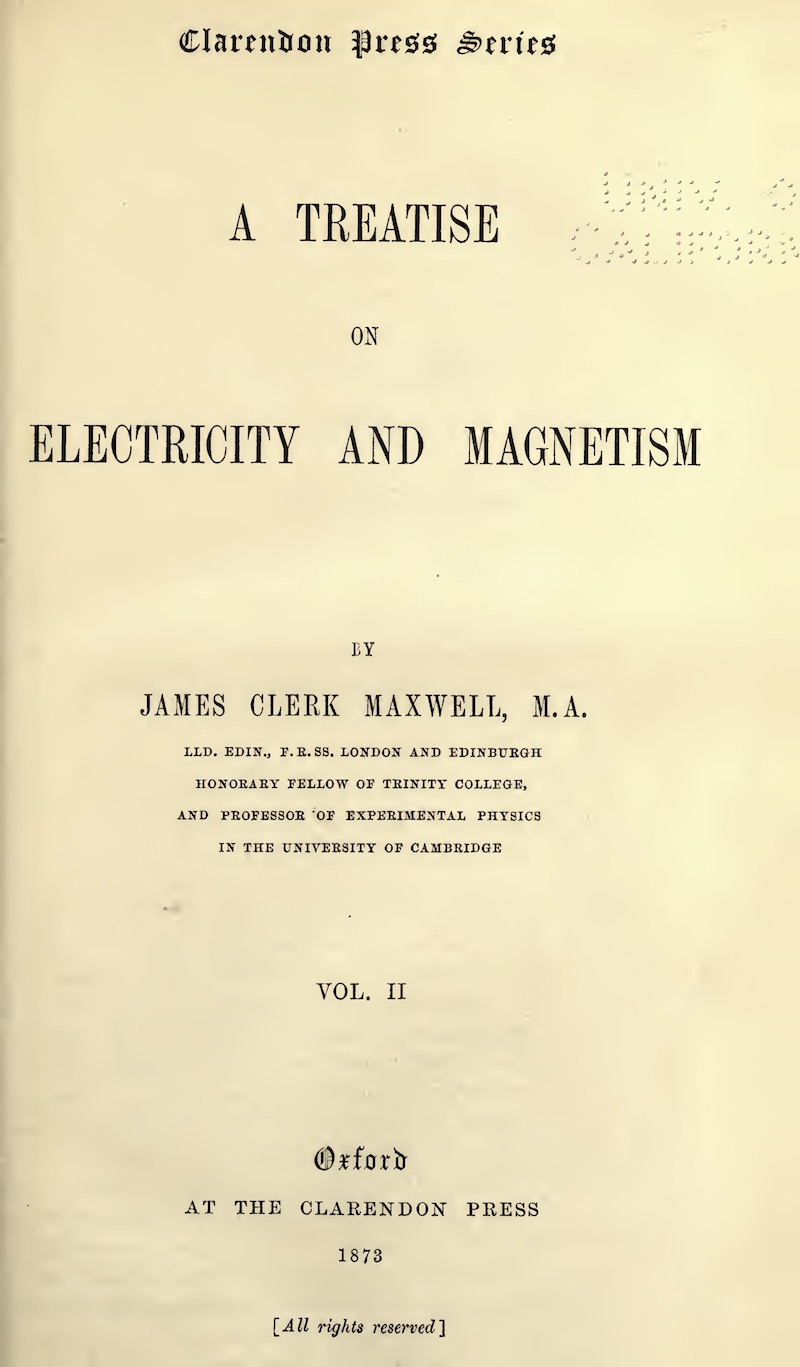
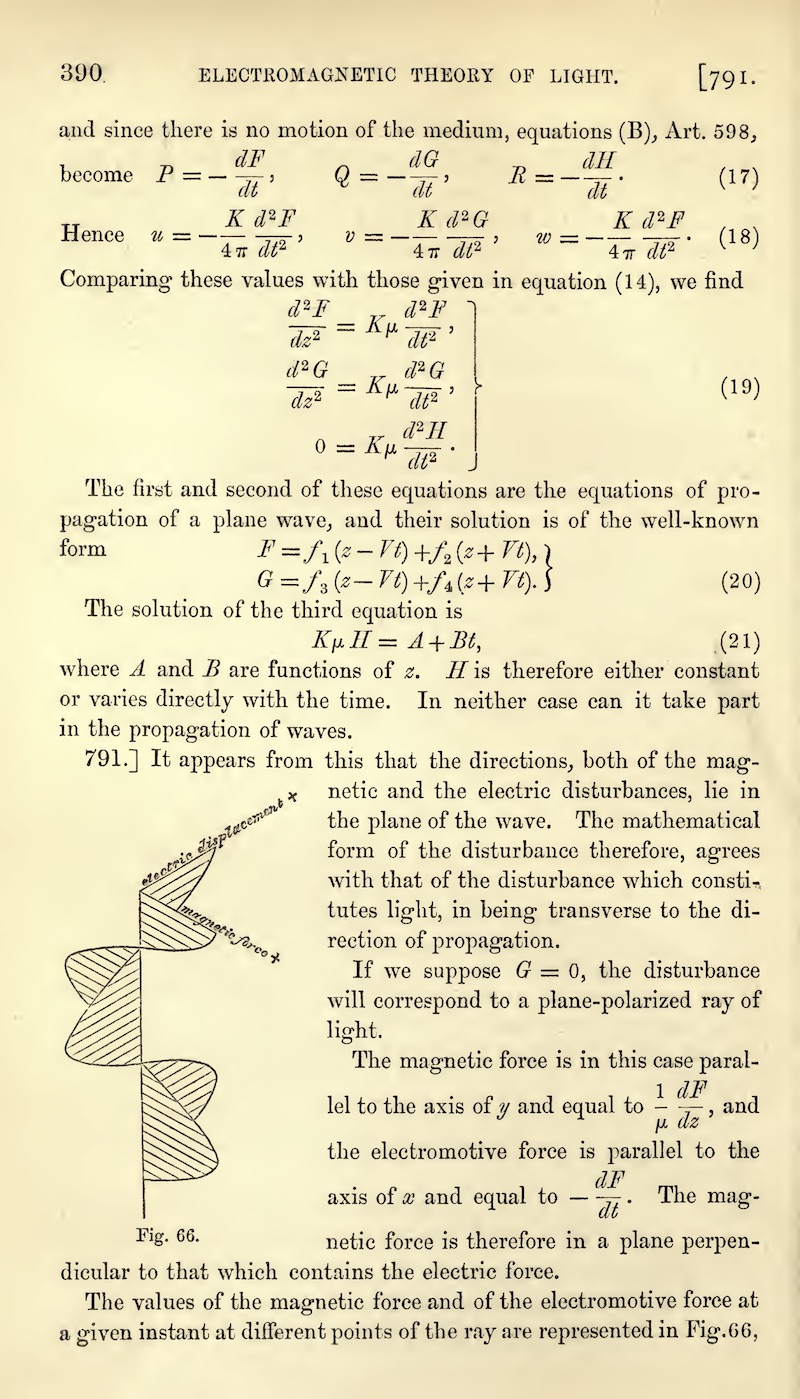
The speed of a light signal was quite unlike the
speed of a pebble, say. The pebble could move at any speed,
depending on how hard it was thrown. It was different with light in
Maxwell's theory. No matter how the light signal was made and projected,
its speed always came out the same. For Maxwell, that speed was always the
same in just one frame of reference, the rest frame of his electromagnetic
ether.
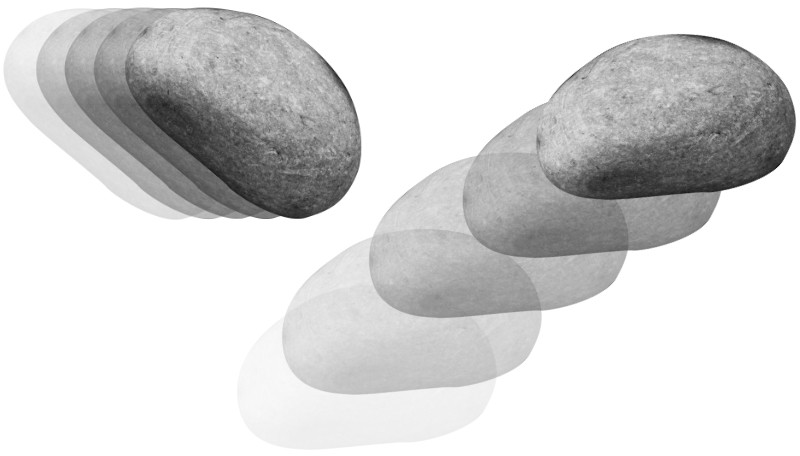
The principle of relativity assured Einstein that the laws of nature were
the same for all inertial observers. That light always propagated at the
same speed was a law within Maxwell's theory. If it held in one inertial
frame of reference, it must hold in all. So, if the principle
of relativity was applied to Maxwell's law about light, the light
postulate resulted immediately.
What you need to know:
- Inertial and accelerated motion.
- Absolute versus relative motion.
- Inertial frames of reference.
- Einstein's two postulates and how to apply them.
Copyright John D. Norton. January 2001; August 30, 2002; July
20, 2006; January 8 2007; January 3, August 21, 27, 2008; January 6 10,
2011; February 10, 2013. January 14, 2022. September 3, 2024



















